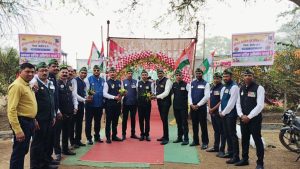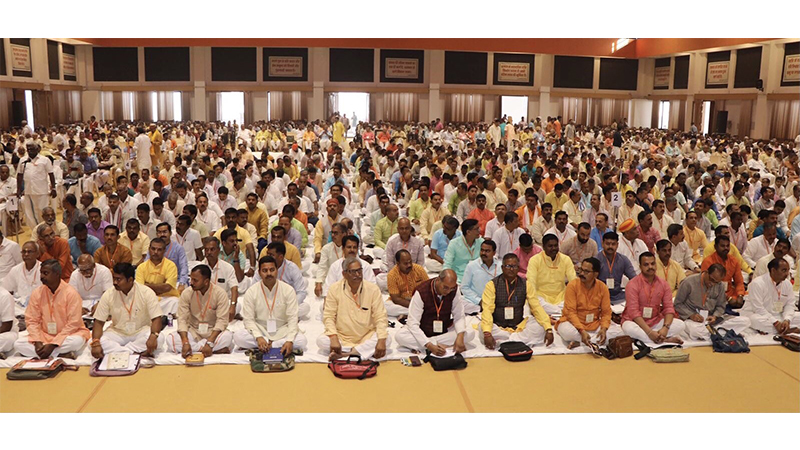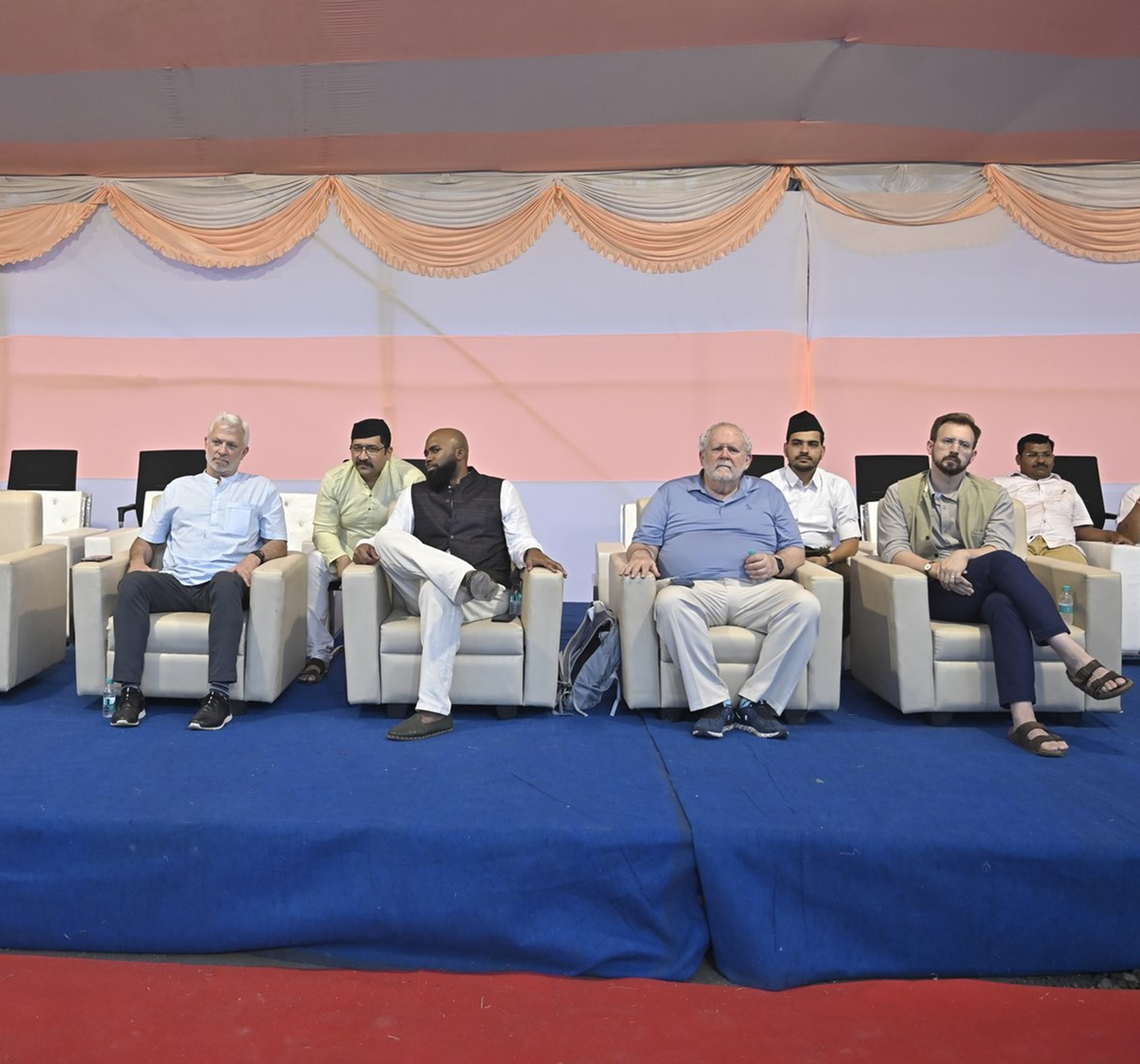How third RSS chief Deoras moulded RSS approach on social harmony and service
Updated: March 4, 2024 16:09

by Dr. Shreerang Godbole
What is the secret of the ceaseless growth and development of the Rashtriya Swayamsevak Sangh (RSS)? How is it that an almost 100-years old organization has not become outdated, rather continues to attract and inspire countless youth? Rootedness in a timeless philosophy, a unique organizational ethic and working, and the model lives of several karyakartas (workers) can explain this phenomenon. Flexibility and adaptability to change have ensured that the Sangh has moved with the times.
The Sangh has also been blessed with Sarsanghchalaks(Chief Mentors) whose personality was in tune with the needs of the organization at the time. Dr. Keshav Baliram Hedgewar(the founder of RSS and its first Sarsanghchalak) was ideal personified. The present day flowering of the Sangh can be traced in its nascent form to his life. Shri Guruji (MS Golwalkar, the second Sarsanghchalak) expounded the Sangh philosophy and consolidated its organizational structure. After Shri Guruji’s passing, the mantle of the Sangh fell on Balasaheb Deoras.
Balasaheb inherited an organization that had outgrown the uncertainties and hostilities of the past. The monumental contribution of Doctorji, Shri Guruji and other first generation Sangh karyakartas(workers) had ensured a strong organizational base and rising goodwill for the Sangh. However, no organization can grow on past laurels. If an organization does not keep pace with the times, it becomes fossilized and irrelevant. At the same time, care has to be taken that the organization does not lose sight of its ideal and go astray. Balasaheb was an idealist, pragmatist and strategist rolled into one. With characteristic humility, Balasaheb disavowed any claim to greatness. He said that the Sangh was blessed with devdurlabh (very exceptional) karyakartas. Looking back, one can only say that the Sangh was fortunate to have a devdurlabh (very exceptional) Sarsanghchalak in the form of Balasaheb. His astute leadership ensured that the Sangh moved from the margins to the centre stage of national life. The social thrust that he gave to the Sangh in the form of the twin attributes of seva (service) and samarasta (social harmony) was undeniably a logical expression of Sangh philosophy. But it was equally a product of his own conviction.
Reformist legacy
Balasheb was an enlightened reformist. From where did Balasaheb inherit this reformist legacy? The Deoras family was well-to-do and had several servants to work on their agricultural land. However, no discrimination was ever practised in the Deoras home. Balasaheb’s father Bhaiyyaji would spend hours performing his daily pooja. Balasaheb’s mother Parvatibai would make all the pooja preparations but would herself merely fold her hands and then spend the day immersed in her chores. She would happily serve food to Bal (nickname of Balasaheb Deoras during childhood) and Bhau’s (nickname of Balasaheb’s brother Bhaurao Deoras, who also became an RSS full time worker) friends from different castes as they inter-dined and cleared away their used dishes.
Parvatibai was Balasaheb’s first teacher. His feelings towards her cannot be described in words. In his personal collection was a photograph of his mother with a solitary word at the bottom –kuladevata (totem). After his mother, it was Dr. Hedgewar who had the greatest influence on Balasaheb. Dr. Hedgewar was a truly progressive man. While still pursuing his medical studies in Kolkata, the young Hedgewar had organized a felicitation function of Dhondo Keshav Karve who was on a visit to collect funds for the first-ever university for women (RSS archives, Nana Palkar Hedgewar notes 3_159). Karve became a path-breaker in women’s education and received Bharat Ratna in 1958. Doctorji had appointed Advocate Purushottam Neelkanth alias Appa Sathe as Sanghachalak of Chiplun, Maharashtra. Adv. Sathe had three children. After his wife passed away, he married a widow named Kashibai Vaidya who had a daughter from her previous marriage. This marriage of a widower and a widow was frowned upon by the orthodoxy in Chiplun. Hence it was solemnised in Pune on 4 December 1937. Among those who attended and implicitly supported this ‘revolutionary’ marriage were Dr. Hedgewar and DK Karve. Dr. Hedgewar and Dr. Ambedkar knew each other well. Dr. Ambedkar had visited the RSS Training Camp in Pune (1939) as also the Sangh shakha(a daily gathering of volunteers) in Karad in January 1940 (RSS archives, Register 1 DSC_0039 02 Jan 1940). In all likelihood, the legacy of seva was inherited by Balasaheb from Doctorji himself. Doctorji had played a prominent role in the founding of the Shraddhanand Anathalaya (orphanage) in Nagpur on 27 February 1927. To give succour to society in times of need, Doctorji started ‘nursing teams’ within the nascent Sangh. It is no accident that Article 8 of the Sangh constitution explicitly states that seva is an integral part of the daily Sangh shakha. Reform of self and society More often than not, those who set out to reform society are not very keen to improve themselves. Balasaheb was an exception. He was of the opinion that reform starts from self.
An anecdote narrated by former Sah Prant Sanghchalak (Deputy provincial head) of Vidarbha Prant(province) Dr. Shriram Joshi is illustrative of his conviction in this regard. Once, Balasaheb was leaving the Mahal Sangh karyalaya to attend a programme. Accompanied by Dr. Joshi and Pandurangpant Savarkar, he was coming down the stairs when he overheard a senior karyakarta remarking that he had reached an age where change was not possible in himself. Balasaheb halted, turned around and told the karyakarta, “You should mend till you end!” Balasaheb had put this precept into practice. In his younger days, Balasaheb would speak too fast. When RSS veteran Appaji Joshi brought this fact to his notice, Balasaheb consciously made efforts to speak slowly. Balasaheb was not one to dwell in the past or get bogged down by the burden of history. He was a man who lived in the present and saw the future. His illustrations would be invariably contemporary. If reading maketh a man, it is easy to understand why Balasaheb was so broad-minded in his approach.
The repertoire of his books included Aleksandr Solzhenitsyn’s The Gulag Archipelago that detailed the horrors of the Soviet forced labour camps and William McCord’s The Springtime of Freedom that discussed the evolution of developing societies. He was equally at ease with a serious book on philosophy as with a novel or a humorous essay. It is well nigh impossible for a person with such diverse interests to become hide-bound. Social harmony entails reconciliation of divergent, even conflicting thoughts and value-systems. It cannot be envisaged by a closed mind. Balasaheb was receptive to diverse ideas. A graduate in Philosophy, Balasaheb felt affinity to the Jain doctrine of Anekantvad which holds that every substance or situation has infinite attributes or qualities and that these different attributes may be seen through different angles. Balasaheb held that one question can have several correct answers. It was Balasaheb who introduced question-answer sessions in the Sangh. He encouraged Sangh swayamsevaks to air their questions openly, sometimes patiently helping an over-awed swayamsevak to frame the question. To him, there could be no silly questions, only silly answers. Balasaheb’s answers would be complete, candid and comprehensible. They would not only clear the questioner’s doubts, but also enrich him as a karyakarta.
Balasaheb was a true democrat. Ability to listen is the first attribute of a democrat. “Courage is what it takes to stand up and speak; courage is also what it means to sit down and listen” said Churchill. Balasaheb’s capacity to listen knew no bounds. Balasaheb would calmly wait for the other person to express himself fully without as much as a hint of irritation. To Balasaheb, ‘ ’ (imbibe truth even if it be from a child)was an aphorism to be practised. Self-proclaimed progressives looked upon the Sangh as a bunch of dogmatic obscurantists out to impose an outdated belief-system. The Emergency saw political workers of different ideological persuasions being kept together in the same prison. When Socialists experienced Balasaheb’s unambiguous progressivism in word and deed in Yeravada Jail, they were gratified. To Balasaheb, no medium was taboo if it could propagate good thoughts. A young swayamsevak named Rajdatt asked Balasaheb, “May I take up film-making as my profession?” “By all means” replied Balasaheb, “No field is taboo for us.” Rajdatt went on to become an acclaimed film-maker. In 1977, he decided to direct a Marathi film on the life of noted saint-reformer Gadge Baba. Balasaheb suggested that Rajdatt lay greater focus on Gadge Baba’s social message and work.
Balasaheb was not an atheist but at the same time, he had no use for rituals. He would neither wear the janeu (sacred thread which many Hindus wear) nor set aside chitrahuti (portion of food as an offering to the gods) before starting his meal. “I will not do anything that sets me apart from my fellow-swayamsevaks” he would remark. He would encourage, assist and on occasion even facilitate inter-caste marriages. He would make it a point to attend such marriages.
Shaping the Sangh Cast in the image of Dr. Hedgewar, Balasaheb was the quintessential Sangh product. The Sangh had moulded him. Equally true, the Sangh was moulded by Balasaheb. Balasaheb firmly believed that Sangh swayamsevaks should not wrap themselves in a cocoon; they should be responsive to social change and participate in the joys and sorrows of those around them; the transformation that the Sangh seeks to bring about in society should get reflected in their daily lives. For several years, the image that common citizens conjured of Sangh swayamsevaks was one of uniformed men doing their route-march. Balasaheb was determined to get rid of such stereotypes. “We should not exhibit ourselves as what we are not” was his refrain.
On 3 an 4 July, 1978, Balasaheb extensively toured the vanvasi(tribal) belt of Maharashtra. In two days, he covered Mokhada, Talasari, Sutrakar, Ambhan, Manor, Palghar, Aunda, Vikramgarh, Jawhar and Wade. Speaking informally to journalists at Talasari on 3 July, he said, ”Two leading all-Bharat karyakartas (national level workers) have been relieved of their responsibilities to enable them to study the vanvasi (tribal) issue. Based on their input, we are thinking of starting new projects throughout the country.” On 4 July, speaking to journalists in Jawhar, he said, “Two all-Bharat and 45-48 provincial karyakartas(workers) shall exclusively bear responsibility of seva work. “ Balasaheb’s emphasis on seva meant that swayamsevaks responded in large numbers in times of natural disasters and immersed themselves in rescue and rehabilitation work. Be it the 1979 Andhra cyclone or the 1982 Rajasthan floods, it became a common sight to see swayamsevaks in protective masks carrying corpses or providing relief to those affected. To be sure, Sangh swayamsevaks had participated in such relief work before as in the 1950 Assam earthquake and floods. The organic growth of the Sangh coupled with Balasaheb’s social thrust ensured that this became a massive panBharat phenomenon. Seva work received a fillip during the centenary year of Dr. Hedgewar in 1989. Balasaheb laid down the contours of samarasta (social harmony) in the Sangh. His speech on Samajik samarasta at the Vasant Vyakhyanmala (estd. 1875), Pune on 8 May 1974 is easily the most important speech ever delivered in Sangh history. With its stress on action, the Sangh has limited use for speeches. If ever a speech has superseded action, this was it. In one stroke, Balasaheb’s words did for the Sangh what its past efforts in the field of samarasta had failed to do. It is noteworthy that Balasaheb had deliberately chosen this topic when he was invited to speak at the Vasant Vyakhyanmala. Balasaheb had gone into great details while preparing his speech. Though himself a scholar of Sanskrit and Philosophy, he had sought the opinion of Krishnashastri Bapat, Nagpur… Balasaheb spent two days at his ancestral home in Karanja village to prepare his speech. He invited ordinary karyakartas from neighbouring villages and read the draft to them. He sought their opinion and prepared the final draft. The speech was then typed in Nagpur; one copy was given to ‘Tarun Bharat’, (a newspaper in Nagpur) before he departed for Pune. Before delivering it, Balasaheb showed the speech to Maharashtra Prant Sanghchalak Babarao Bhide who was regarded as a conservative. Bringing clarity to confusion Before Balasaheb’s momentous speech, critics had a field day accusing the Sangh of being a champion of chaturvarnya and the caste-system. In particular, they would quote out of context Shri Guruji’s comments on chaturvarnya made in course of an interview to Marathi daily Navakal. As a result, swayamsevaks would go on the defensive. There was also a certain lack of clarity in the minds of many swayamsevaks about the Sangh’s stand on social issues. They spent their energy lamely trying to answer their wily opponents, often justifying every deed of their ancestors. Balasaheb brought the Sangh out of the corner into which its opponents had boxed it. He changed the rules of the discourse. Rather than going into the past, he unambiguously declared that the need of the hour was a society free of exploitation and imbued with social equality. The word of the Sarsanghchalak at once cleared the cobwebs in the minds of swayamsevaks and silenced the critics. The social thrust provided by Balasaheb ensured that the Vanavasi Kalyan Ashram (an RSS-inspired organisation that works amongst tribals) became a national organization. The beginning of the Seva Bharati work (1979), the resolution on reservation at Akhil Bharatiya Pratinidhi Sabha of the Sangh (1981), the formation of the Samajik Samarasta Manch in Maharashtra (1987), launch of hundreds of seva (service)projects in Dr. Hedgewar’s birth centenary year (1989), celebrations of Dr. Ambedkar’s birth centenary (1990), work among the nomadic tribes (1991) were a natural corollary of Balasaheb’s vision. Balasaheb set the Sangh on a trajectory from where going forward with greater vigour is the way ahead.












